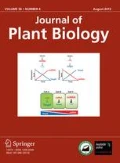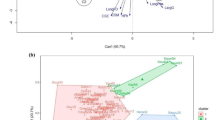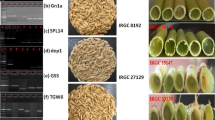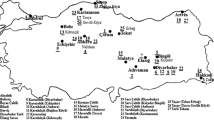Abstract
Off-type rice plants occurring in farm fields cause yield loss due to competition with cultivated rice, in addition to hindering field management and harvest work. This study aimed to observe the agronomic characteristics and trace the origins of off-type rice plants using molecular markers. A total of 116 rice accessions, comprising 35 off-type plants collected from Korean farm fields, 19 Korean commercial cultivars, 12 Korean land races, and 50 weedy rice collections, were phenotyped and genotyped using selected SSR and Subspecies Specific (SS)-STS markers. The results showed that the plant height, culm length, and leaf length of off-type rice plants were larger than those of cultivated rice, which is the typical phenotype of weedy rice. However, off-type plants were highly sterile, as opposed to weedy rice, which were highly fertile. Genotype analysis with SSR and SS-STS markers revealed that off-type rice plants were heterozygous at most of the tested marker loci, suggesting that the off-type rice plants may have originated from natural outcrossing. The genotypes of off-type rice plants were closely related to both weedy and cultivated rice, and the phylogenetic analysis revealed that the relationship of the clustered group of offtype rice plants is intermediate between Indica type weedy rice and Japonica type commercial varieties. These results suggested that off-type rice plants collected in Korean farm fields might have originated from natural outcrossing between Indica type weedy rice and the cultivated Japonica type commercial varieties.
Similar content being viewed by others
References
Alvarado AR, Pedreros LA (1991) Presence of red rice in Chile. Agricultura Tecnica 51:374–377
Causse MA, Fulton TM, Cho YG, Ahn SN, Chunwongse J, Wu K, Xiao J, Yu Z, Ronald PC, Harrington SE (1994) Saturated molecular map of the rice genome based on an interspecific backcross population. Genetics 138:1251–1274
Chen LJ, Lee DS, Song ZP, Suh HS, Lu BR (2004) Gene flow from cultivated rice (Oryza sativa) to its weedy and wild relatives. Ann Bot 93:67–73
Chin J-H, Kim J-H, Jiang W, Chu S-H, Woo M-O, Han L, Brar D, Koh H-J (2007) Identification of Subspecies-specific STS markers and Their Association with Segregation distortion in Rice (Oryza Sativa L.). J Crop Sci Biotech 10:175–184
Cho Y-G, Jung JW, McCouch SR (2007) Genetic Diversity and Population Structure of Korea Rice Germplasm Based on SSR Marker Analysis. Journal of Agricultural Science Research, Chungbuk Natl Univ 23:107–119
Diarra A, Roy J Smith J, Ronald ET (1985) Interference of Red Rice (Oryza sativa) with Rice (O. sativa). Weed Science 33:644–649
Ellstrand NC, Prentice HC, Hancock JF (1999) Gene Flow and Introgression from Domesticated Plants into Their Wild Relatives. Annu Rev Ecol Syst 30:539–563
Ji H, Koh H, Park S, Susan RM (1998) Varietal Identification in Japonica Rice Using Microsatellite DNA markers. Korean J Breeding Sci 30:350–360
Kim D, Jin I, Song D, Kim Y (2001a) Occurrences and characteristics of the off-type rice plant in farmer’s paddy field. Korean J Crop Sci 46:170–175
Kim D, Kwon O, Shin H, Jin I, Jung B (2001b) Occurrence and Characteristics of Off-type Rice as affected by Cultural Practice. Korean J Crop Sci 46:429–133
Kim DK, Kwon OD, Shin HR, Jin ID, Jung BG (2001) Occurrence and Characteristics of Off-type Rice as affected by Cultural Practice. Korean J Crop Sci 46:429–133
Lee J, Jeon Y, Hwang H (2004) Occurrence of off-type plants in japonica/indica hybrid rice cultivars. Korean J Plant Resources 7:141–146
Liu K, Muse SV (2005) PowerMarker: an integrated analysis environment for genetic marker analysis. Bioinformatics 21:2128–2129
Noldin J (1998) Red Rice Situation and Management in America. International Symposium on Wild and Weedy Rices in Agro — Ecosystem, Ho Chi Minh City, Viet Nam, 36–11
Oka HI (1988) Origin of cultivated rice, National Inst. Genetics
Rohlf F (1997) NTSYSpc, version 2.02. Exeter Software. Applied Biostatistics Incorporated
Suh H (2008) Weedy Rice
Suh H, Cho J, Suh J (2002) Phylogenetic relationships among wild, weedy and cultivated rices based on F1 fertility, isozyme and RAPD variation. Korean J Breeding Sci 34:174–177
Suh HS, Sato YI, Morishima H (1997) Genetic characterization of weedy rice (Oryza sativa L.) based on morpho-physiology, isozymes and RAPD markers. Theor Appl Genet 94:316–321
Watanabe T, Yamamoto A, Nagai S, Terabe S (1997) Separation and Determination of Monascus Yellow Pigments for Food by Micellar Electrokinetic Chromatography. Anal Sci 13:571–575
Author information
Authors and Affiliations
Corresponding author
Rights and permissions
About this article
Cite this article
Lee, J., Park, JH. & Koh, HJ. Morphological and genetic characterization of off-type rice plants collected from farm fields in Korea. J. Plant Biol. 56, 160–167 (2013). https://doi.org/10.1007/s12374-013-0094-6
Received:
Accepted:
Published:
Issue Date:
DOI: https://doi.org/10.1007/s12374-013-0094-6




